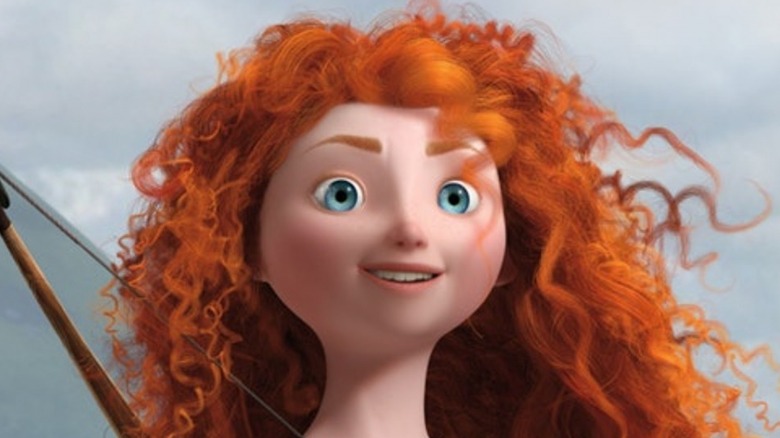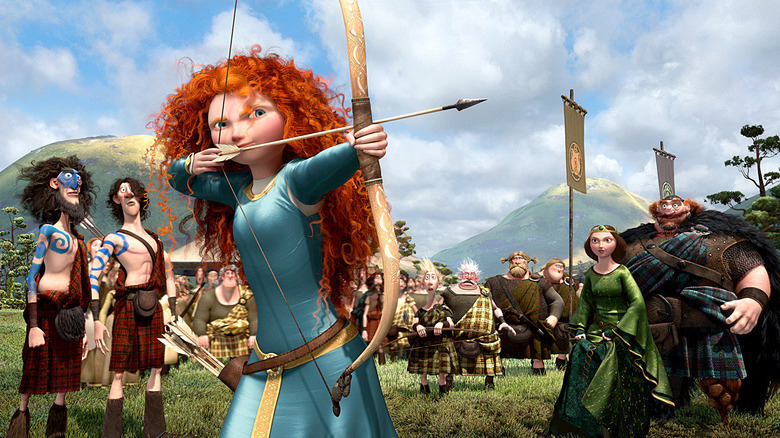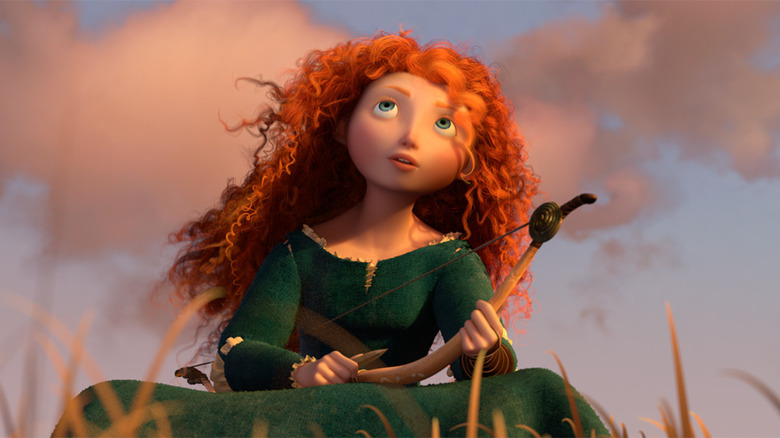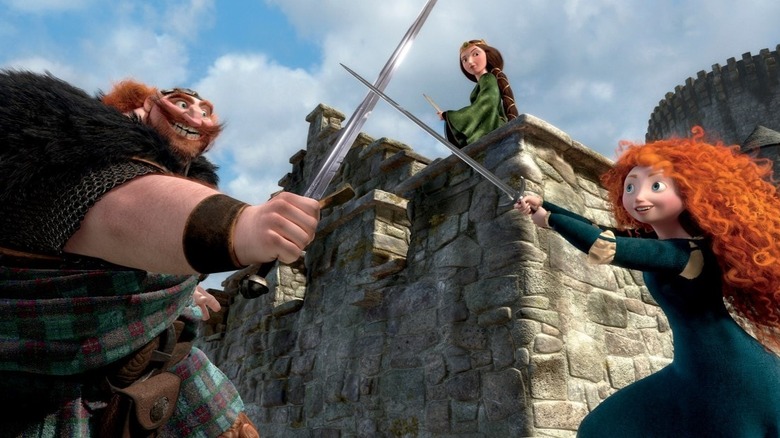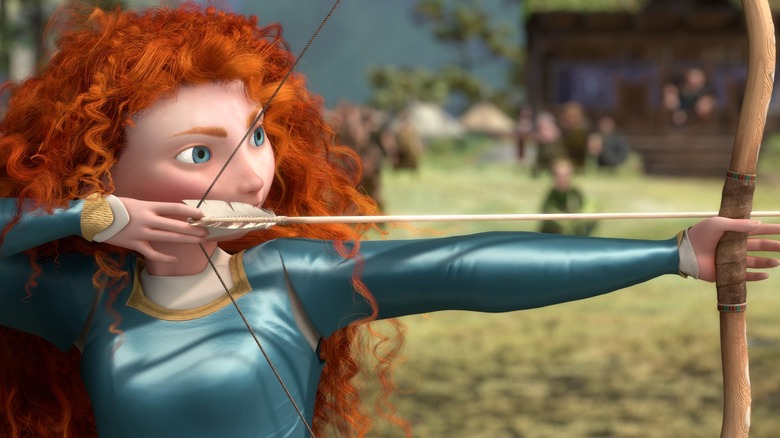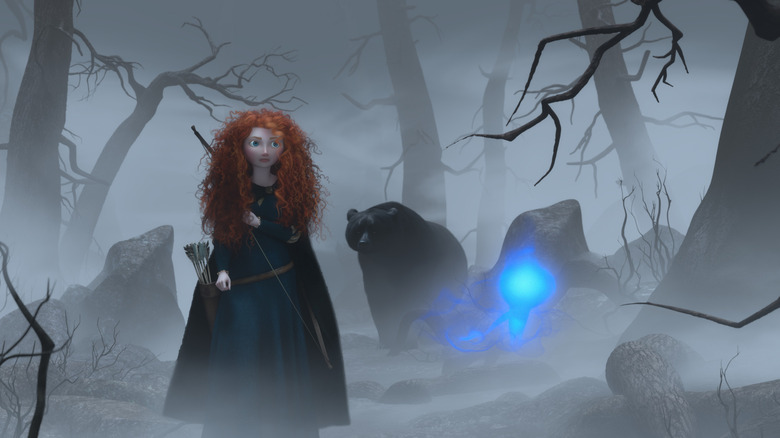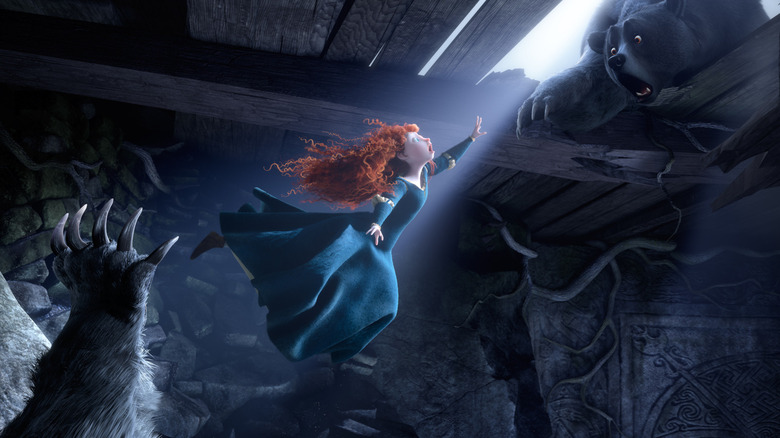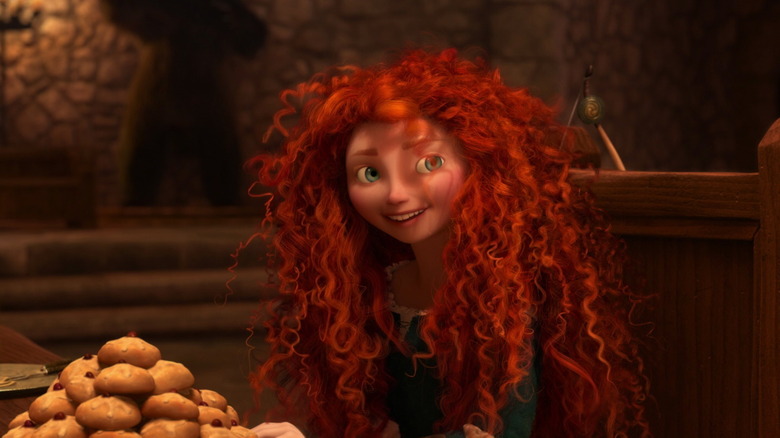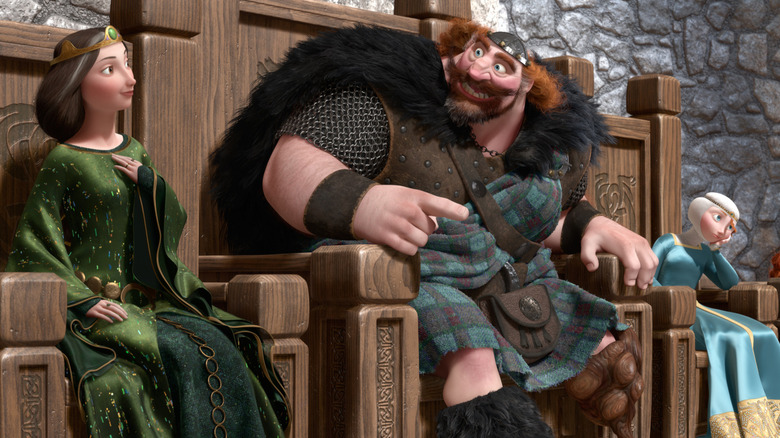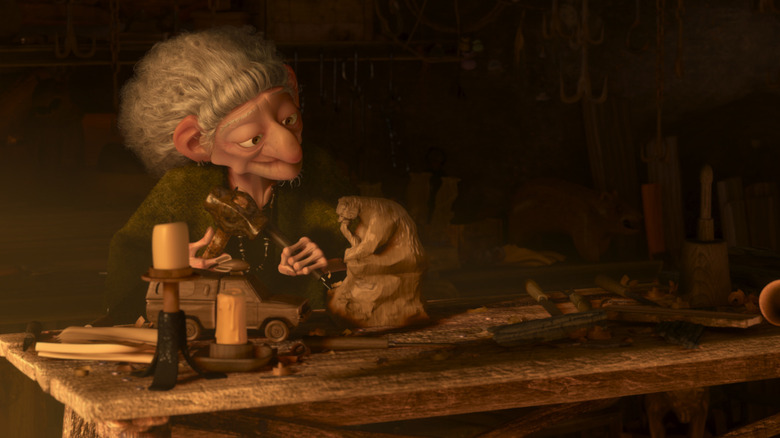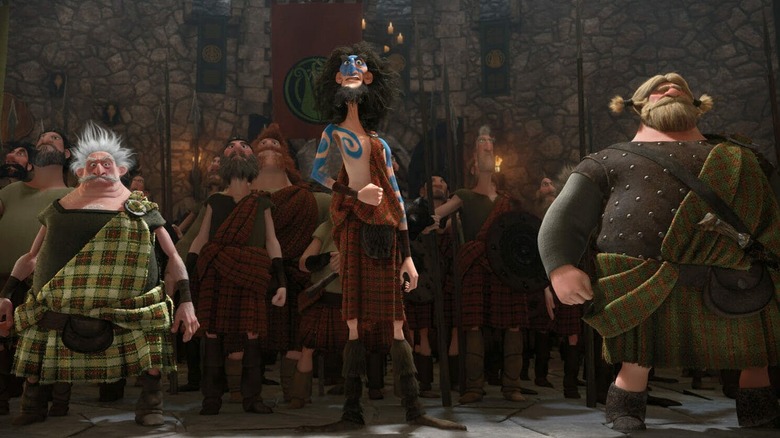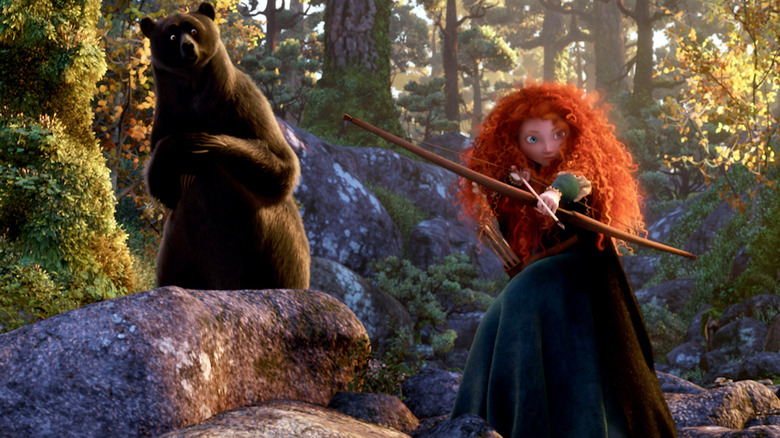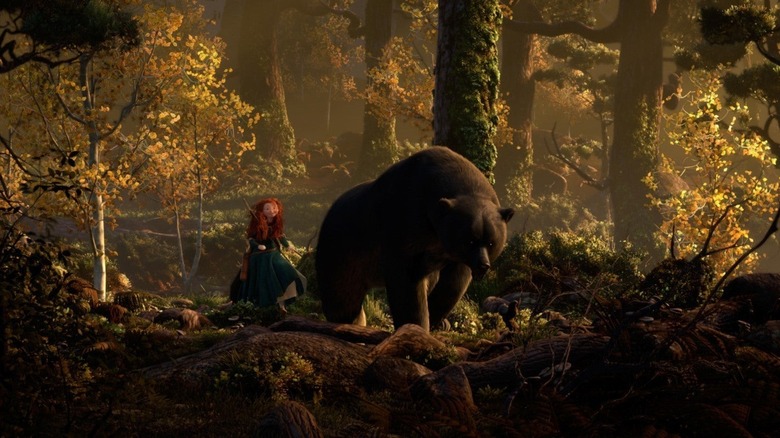The Untold Truth Of Brave
In 2012, Pixar Animation Studios delivered "Brave," a title that marked several firsts for the studio. Most obviously, it was the first time the company behind "Toy Story" and "The Incredibles" managed to deliver a feature with a woman as the protagonist and it was also the first Pixar project made in the mold of a fairy tale. Coming off of "Toy Story 3" and "Cars 2," "Brave" served as the first non-sequel for Pixar since "Up" in 2009 and would be the final non-sequel for the studio until "Inside Out" in 2015. There was a lot of notoriety surrounding the reputation of "Brave" as well as its place in the Pixar canon.
These notable attributes, as well as the project's positive reception among critics and audiences, have helped keep "Brave" firmly planted in the public consciousness. However, much like its lead character, there's much more to "Brave" than meets the eye. The backstory of "Brave" is chock full of fascinating details reflecting the long and winding road this movie took to get to the big screen. It's time to grab your bow and arrow and prepare to change your fate by reading all about the untold truth of "Brave."
The original title of Brave
In April 2008, Disney held a press event where it shared details and titles for its various upcoming animated movies (via Reuters). Projects that would eventually become pop culture phenomena like "Up" were unveiled to the world while productions that were later canceled such as "Newt" and "King of the Elves" also received highlights. Revealed publicly for the first time was the original incarnation of "Brave," though it carried a decidedly different name at this juncture.
Years before its release, "Brave" was known as "The Bear and the Bow." Viewers of the movie will instantly recognize this as a reference to both the plot detail of Merida's mom transforming into a bear and the character's own love for archery. The news eventually came out that this moniker was being swapped for the final title of "Brave."
While talking about the film in 2012, producer Katherine Sarafian revealed that the feature's first title was "Brave" before switching to "The Bear and the Bow." Sarafian's later comments hint that the jettisoning of the "Bear and the Bow" had to do with keeping plot details related to the bear transformation more of a secret from viewers before they saw "Brave." Plus, returning to this single-word title ensured that "Brave" would fit right in with the naming scheme Disney adopted for its animated fairy tales starting with "Tangled."
First director Brenda Chapman's inspiration for Brave
The universe of "Brave" was the brainchild of the film's original director, Brenda Chapman. This filmmaker, who previously helped helm "The Prince of Egypt" in 1998, planned on making something deeply rooted in fantastical Scottish mythology, but also tangibly human. At the heart of this story of bears and curses would be a relatable yarn of mother/daughter struggles. That part of the narrative was near and dear to Chapman's heart.
As she explained to Ms. Magazine in July 2012, Chapman's concept for "Brave" was partially inspired by the affection she carried for old-school fairy tales as well as a passion for Scotland. However, the primary driving force for the entire movie was her connection to her daughter. Chapman's daughter always challenged her authority, to the point that she referred to her as "my Merida." The rapport between these two greatly informed the mother/daughter dynamic in "Brave."
In the same interview, Chapman noted that not only did her daughter end up adoring "Brave," but that she was honored to have helped inspire its creation. Channeling authentic reality like that deepened Chapman's personal connection to the material while also grounding all the high-concept fantasy elements with something highly relatable.
The reason Chapman departed from Brave
In October 2010, Brenda Chapman was let go from her passion project. It's not unusual for Pixar movies to lose their directors midway through production, as seen in everything from "Ratatouille" and "The Good Dinosaur" to "Cars 2." For "Brave," Chapman was replaced by "One Man Band" director Mark Andrews while Steve Purcell took over as co-director. Talking to Den of Geek in 2012, Andrews said he was brought onboard because "Brave" was plagued by story issues. He felt it was necessary for somebody who wasn't originally part of "Brave" to come in with a "clear headspace."
However, in 2018, Chapman spoke to Polygon about her difficulties making "Brave" and alleged that a different set of problems beyond just story challenges led to her departure. Specifically, she said, "I hit a lot of the issues with being a woman and also trying to put forward a female-led story." She also claimed that her conflicts with former Pixar chief creative officer John Lasseter related to her being let go as the director of "Brave." Chapman further remarked that plans to shift "Brave" to a father-daughter narrative didn't work out and the film circled closer back to her original mother-daughter vision.
Many Pixar movies have changed directors, but few reportedly have had as much conflict surrounding them as the filmmaker turmoil behind "Brave."
What director Mark Andrews brought by taking over Brave
It's a tricky proposition taking over a movie from another director. You may not have come up with the idea for the film, but now you have to lend it all the creative passion and precision as if you've been nursing the concept for years. Director Mark Andrews faced this unenviable task when taking over "Brave" from filmmaker Brenda Chapman. It was a complex labor tackling an undertaking already deep into production, though at least Andrews knew where he wanted to lead the project he was assuming responsibility for.
Speaking to SlashFilm, Andrews revealed that his biggest alteration to the original version of "Brave" spearheaded by Chapman was the presence of magic. While the final film would still involve a witch and spells, there were even more supernatural elements initially scattered throughout "Brave." Coming aboard as the new director, Andrews opted to whittle down the presence of these elements. He also decided to "clean everything out" in the narrative and make sure all the aspects of "Brave" circled back to the worldview of Merida. With these creative goals in hand, Andrews was able to figure out where he wanted to take "Brave" as its new director.
Why Reese Witherspoon dropped out of voicing Merida
When you think of "Brave," it's impossible to separate it from its Scottish backdrop. This is especially true since the cast is largely comprised of notable Scottish talent, including Kelly Macdonald as the voice of protagonist Merida. Originally, this character's vocal performer would've been a departure from the rest of the cast in being deeply American. Reese Witherspoon, famous for movies like "Legally Blonde" but not for playing characters with foreign accents, was cast initially cast as Merida.
Witherspoon was set in the role of Merida for awhile before she eventually stepped away from the project in March 2011. At the time, it was noted that scheduling conflicts with other productions Witherspoon had to attend to were behind this recasting (via Variety). Macdonald took over the part and that seemed to be the end of it until Witherspoon later let some choice details slip.
In an interview on the show Lorraine (per Cosmopolitan), Witherspoon, while talking about difficult accents to nail, mentioned that Scottish was an especially hard one to crack and that she'd previously lost out on a role because of her inability to deliver an authentic Scottish accent. The obstacle eventually became insurmountable, and Witherspoon opted to drop out. While she didn't specifically name "Brave" as the project she left, it seems to fit the information she provided.
Kelly Macdonald's experience joining the Brave cast late
After Reese Witherspoon dropped out of "Brave," Kelly Macdonald got her chance to anchor the cast of a Pixar blockbuster. In talking to Den of Geek about her experiences on the film, Macdonald made it no secret that she wasn't initially supposed to be in "Brave." Despite being a latecomer to the project, Macdonald managed to find her footing quickly by channeling her own teenage experiences into the character of Merida.
Though she admitted that she was "never as feisty and as outdoors-y as Merida," Macdonald remembered her days of being a teenager and believing she already knew everything there was to know about the world. Connecting to that part of her past, she found a voice for Merida "pretty easily" and hit the ground running with the role. Even if she wasn't a part of the original lineup of "Brave," Macdonald cemented herself as a natural component of the production by basing her vocal performance on her memories of being a teenager.
Macdonald's awareness that Merida is bigger than one actor
Playing a Disney princess is akin to playing a character in a William Shakespeare play. You're not going to be the only one inhabiting the role, and chances are, you're not even the first one to take on the part. These are characters that are bigger than one human being and that includes the people who wrote them in the first place. Figures like Ariel, Snow White, or Elsa endure for so long that they could never be tied down to just one performer. Merida, the first Disney princess to emerge from Pixar Animation Studios, was no exception and her voice actor, Kelly Macdonald, is no stranger to this fact.
Talking to Den of Geek, Macdonald noted that she didn't think about the grander importance or lasting legacy of Merida when she was recording her lines for the character. But at the time of the interview, she was becoming more and more conscious of how Merida was taking on a life of her own by showing up as a walkaround character at Disneyland or merchandise in Disney stores. She was also cognizant of the unavoidable fact that "there's going to be lots of other Meridas around the place, around the world, doing the voice." Macdonald brought a lot of fiery rebellion to Merida's vocals that solidified her beloved status, but just like with any other Disney princess, this character is so much bigger than any one actor.
Co-director Steve Purcell's fondest memory from making Brave
Creating an animated movie, especially one as big in scope as the titles from Pixar, is an expansive effort. Thus, it can be hard for any creative participant in such projects to pick out one memory that encapsulates all of their experiences working on the endeavor. How can you distill years of blood, sweat, and tears into just one moment? It sounds like an impossible task, but for "Brave" co-director Steve Purcell, there's no question what aspect of the film's production left the biggest mark on him.
Talking to Animation Scoop, Purcell revealed that the crew's research trip to Scotland is what lingers in his mind as his most cherished memory of working on "Brave." Having never visited Scotland, Purcell was astonished by the glorious castles, landscapes, and mythology that the country offered. There, Purcell and the other key members of the crew on "Brave" got a keener eye for the country that the Pixar title depicted. It was a momentous occasion, one that Purcell holds close to his heart "I think the movie is a love letter to Scotland — visually it's like being there," said the co-director.
How Brave approached period-era discrepancies
"Brave," unlike a lot of other Pixar movies, is not set in contemporary times. It's a period piece that takes place centuries ago in Scotland. This allowed the film to make use of locations and objects that just wouldn't be as commonplace in the modern world, including castles and even the sport of archery. But, unsurprisingly for a movie involving witches and magical bears, "Brave" is not meant to be a documentary. There are countless discrepancies between what appears on-screen and the reality of the time period it's set in, all of which were conscious choices on the part of the filmmakers.
Speaking to Den of Geek, director Mark Andrews noted that when he joined the production of "Brave" he was "not worried" about historical accuracy. As an example, he noted that the stone castles that heavily populate the story didn't emerge until after the period in which "Brave" transpires. Similarly, the modern conception of kilts and various weapons were also nonexistent in that era. For Andrews, the goal of the film was "to have a sense of an authenticity," but not to get bogged down in strict adherence to everything that did or didn't happen in the era of history. With this mandate in mind, the production crew of "Brave" could charge ahead on making an entertaining family movie without getting too concerned about violating every historical detail of the time period.
The biggest animation hurdle in making Brave
When making any animated movie, you're bound to run into unforeseen problems. These issues can range from budgetary restrictions determining the costume and character designs to certain textures being impossible to render in the medium. While talking to Animation Scoop, "Brave" co-director Steve Purcell didn't hesitate to point out the most challenging part of the visuals in the Pixar title. The inconsistencies of the Scottish landscape and costumes proved to be a nightmare to get right on the computers used to realize "Brave."
Purcell observed how the animation ran counter to what films made on computers were supposed to look like, since "the computer wants to organize everything, [but] our movie is made out of things that are random." For example, the moss-covered surfaces in Scotland and Merida's curly hair all needed to be jagged and unique to look just right to audiences. Computer animation, meanwhile, is supposed to provide smooth and crisp edges and textures. The opposition created lots of conflict in the production of "Brave," but Purcell commended the feature's animation department for never backing down on their ambitions. The team was able to realize all those wonderful imperfections that make the world of "Brave" so enchanting.
Why Brave marketing concealed the movie's biggest twist
While watching the trailers and commercials for "Brave" after viewing the movie, something immediately stands out. The plot point about Merida's mother being turned into a bear is nowhere to be seen. Granted, shots of a bear are prominent in the trailer and the creature can even be glimpsed on the film's poster. However, the promotional materials for "Brave" largely downplayed the presence of a bear, let alone the critical fact that this bear was the main character's mom. Given how often modern trailers give away whole movies, it can be surprising to be reminded that a film like "Brave" exhibited such restraint in its marketing.
While talking to Den of Geek, producer Katherine Sarafian noted that concealing this element of the plot was a deliberate choice. In her experience, movie marketing gives everything away far too often. She referenced the trailers for "The Iron Giant" showing off the titular character being able to fly as a perfect example of overt spoiler-filled marketing materials. With the trailers for "Brave," everyone involved wanted there to be exciting surprises waiting for audience members when they got into the theater. As a result, the marketing campaign for "Brave" was much less grizzly than the final film.
The box office run of Brave
When "Brave" came to theaters, it launched in a world before "Frozen." Even though "Tangled" became a massive hit two years earlier in 2010 (per Forbes), there was still uncertainty surrounding the idea of a straightforward animated fairy tale making big bucks at the box office. Pre-release concerns about "Brave" also focused on whether or not having a female lead would alienate young boys and prevent them from seeing the feature.
Those worries ended up being misplaced, as "Brave" became a tidy hit in its theatrical run. The film pulled in $237.2 million at the domestic box office, putting it above many other Pixar projects, including titles like "Toy Story," "Ratatouille," and "WALL·E." It even pulled ahead of the lifetime gross of additional animated fairy tales on the market, such as juggernauts like "Aladdin." Even better, the box office success of "Brave" was not just limited to domestic theaters. Merida resonated with moviegoers overseas, as seen by the $538.9 million worldwide haul of the movie. This proved comparable to the $592.4 million global gross of "Tangled."
Among 2012 titles, "Brave" was the 13th largest release of the year worldwide (via Box Office Mojo), outpacing the likes of "Wreck-It Ralph," "Django Unchained," and "Prometheus." Not only was "Brave" another box office winner for Pixar, but it was a clear indicator that audiences were once again craving entertaining fairy tales free of self-referential snark.
